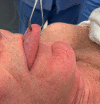Securing the Airway in Maxillofacial Trauma Patients: A Systematic Review of Techniques
- PMID: 33995830
- PMCID: PMC8108104
- DOI: 10.1177/1943387520950096
Securing the Airway in Maxillofacial Trauma Patients: A Systematic Review of Techniques
Abstract
Study design: The present study is a systematic review of the literature.
Objective: The goal of this study is to review our experience and the current literature on airway management techniques in maxillofacial trauma.
Methods: Independent searches of the PubMed and MEDLINE databases were performed from January 1, 2019 to February 1, 2019. Articles from the period of 2008 to 2018 were collected. All studies which described both airway management and maxillofacial trauma using the Boolean method and relevant search term combinations, including "maxillofacial," "trauma," and "airway," were considered.
Results: A total of 452 relevant articles in total were identified. Articles meeting inclusion criteria by abstract review included 68 total articles, of which 16 articles were focused on airway management techniques for maxillofacial trauma in the general population and were deemed appropriate for inclusion in the literature review.
Conclusions: Establishing an effective and stable airway in patients with maxillofacial trauma is of paramount concern. In both the acute setting and during delayed reconstruction, special considerations must be taken when securing a reliable airway in this patient population. The present article provides techniques for securing the airway and algorithms for utilization of these techniques, including both during the initial evaluation and the definitive operative management.
Keywords: difficult airway; intubation; maxillofacial trauma; submental intubation; tracheostomy.
© The Author(s) 2020.
Conflict of interest statement
Declaration of Conflicting Interests: The author(s) declared no potential conflicts of interest with respect to the research, authorship, and/or publication of this article.
Figures









Similar articles
-
Airway Management of the Patient with Maxillofacial Trauma: Review of the Literature and Suggested Clinical Approach.Biomed Res Int. 2015;2015:724032. doi: 10.1155/2015/724032. Epub 2015 Jun 16. Biomed Res Int. 2015. PMID: 26161411 Free PMC article. Review.
-
Submental intubation: alternative short-term airway management in maxillofacial trauma.J Korean Assoc Oral Maxillofac Surg. 2016 Jun;42(3):151-6. doi: 10.5125/jkaoms.2016.42.3.151. Epub 2016 Jun 27. J Korean Assoc Oral Maxillofac Surg. 2016. PMID: 27429937 Free PMC article.
-
Airway management in maxillofacial trauma: do we really need tracheostomy/submental intubation.J Clin Diagn Res. 2014 Mar;8(3):77-9. doi: 10.7860/JCDR/2014/7861.4112. Epub 2014 Mar 15. J Clin Diagn Res. 2014. PMID: 24783087 Free PMC article.
-
Current perspectives in intra operative airway management in maxillofacial trauma.J Maxillofac Oral Surg. 2012 Jun;11(2):138-43. doi: 10.1007/s12663-011-0316-8. Epub 2011 Dec 23. J Maxillofac Oral Surg. 2012. PMID: 23730059 Free PMC article.
-
Airway management in maxillofacial trauma.J Anaesthesiol Clin Pharmacol. 2021 Jul-Sep;37(3):319-327. doi: 10.4103/joacp.JOACP_315_19. Epub 2021 Oct 12. J Anaesthesiol Clin Pharmacol. 2021. PMID: 34759538 Free PMC article. Review.
Cited by
-
Airway management in self-inflicted gunshot wounds to the face.Surg Pract Sci. 2022 Aug 2;10:100118. doi: 10.1016/j.sipas.2022.100118. eCollection 2022 Sep. Surg Pract Sci. 2022. PMID: 39845593 Free PMC article.
-
Factors influencing lower respiratory tract infection in older patients after general anesthesia.J Int Med Res. 2021 Sep;49(9):3000605211043245. doi: 10.1177/03000605211043245. J Int Med Res. 2021. PMID: 34521241 Free PMC article.
References
-
- Allareddy V, Allareddy V, Nalliah RP. Epidemiology of facial fracture injuries. J Oral Maxillofac Surg. 2011;69(10):2613–2618. - PubMed
-
- Tan JY, Khoo WX, Hing EC, et al. An algorithm for the management of concomitant maxillofacial, laryngeal, and cervical spine trauma. Ann Plast Surg. 2016;77(Suppl 1):S36–S38. - PubMed
-
- Cook TM, MacDougall-Davis SR. Respiration and the airway: complications and failure of airway management. Br J Anaesth. 2012;109(Suppl 1):68–85. - PubMed
-
- Cook TM. Strategies for the prevention of airway complications—a narrative review. Anaesthesia. 2018;73(1):93–111. - PubMed
-
- Horton CL, Brown CA, 3rd, Raja AS. Trauma airway management. J Emerg Med. 2014;46(6):814–820. - PubMed
LinkOut - more resources
Full Text Sources
